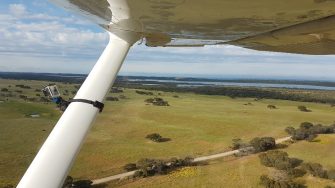
Date: Wednesday, October 25, 2017
Project: Eastern Australian Waterbird Survey
Once again – the weather dominated early. Leaving at about seven, we hoped to dodge the rain coming in. First, we finished the rest of Band 1, along to Port Fairy, past Tower Hill Wildlife Reserve and then headed north to Kingston in South Australia which is where our Survey Band 2 began on the southernmost end of the Coorong. The cloud was low as we made our way up there. We have had to abandon surveying this leg before and come back later in fine weather. Thankfully the clouds lifted and we got on with the job.
Tower Hill Wildlife Reserve in Victoria, just west of Warrnambool.
The wetlands of the southern Coorong were exciting today. There were thousands of waterbirds. Even on the often highly saline lagoons just in from the coast, there were flocks of 50-100 grey teal and two flocks of banded stilts. It was a great sight.
Looking back across to the lagoons and out to sea, on the southernmost part of the Coorong.
Here there is a system of dunes and strings of wetlands nestle between the dunes. They are shallow and often many are dry. There wasn’t as much water as last year but there were large numbers of waterbirds and high diversity. It was a magic part of the survey, even though we are flat out counting.
We then had quite pleasant flight, temperature wise, a welcome break, given we had to work hard over the Coorong. We refuelled at Horsham. The country looked surprisingly green and there was even new windfarm since last year.
New windfarm west of Horsham, near the Victoria and South Australian borders.
After lunch – destination Wangarratta. Along the way, we surveyed the Loddon and Campaspe Rivers and a few storages and natural wetlands in between. The pattern was the same – there were many more waterbirds on every bit of water than last time we were out here.
The highlight was the Corop wetlands, including the Wallenjoe system. I always look forward to surveying these wetlands, east of Elmore in Victoria. Often the big lakes, such as Lake Cooper, have few birds because they are held full for water management. In all the years we have surveyed this lake, today was different. Lake Cooper had thousands of waterbirds, including many grey teal, coot, swans, avocets, small migratory wading birds and even the odd freckled duck. It was busy but great to survey. The lake was obviously drying back, a time when these systems are incredibly productive, with lots of different invertebrates, particularly crustaceans and insects – great food for ducks.
Lake Cooper with its swans and ‘rafts’ of hundreds of coot.
After we finished, we flew around Waranga Basin. This large dam is usually very poor for waterbirds but it had more than usual, including black duck, swans, grey teal and shelduck. From here, we picked up a few storages and sewage works. One had hundreds of pink-eared duck. They really concentrate on very few wetlands, quite different to most other waterbird species.
Finally, we finished off the survey just north of Benalla on Lake Mokoan, also known as the Winton wetlands https://wintonwetlands.org.au/ . This system has transformed from just a storage for managing irrigation water to now a shallow water productive wetland, albeit now considerably smaller than it used to be. It was about 40% of its full size today, but full of a wide diversity of many species of waterbirds. There were lots of grey teal in particular, many more than I have ever seen on this lake. This probably reflected a combination of dry wetlands inland and presumably improved productivity of the wetlands.
